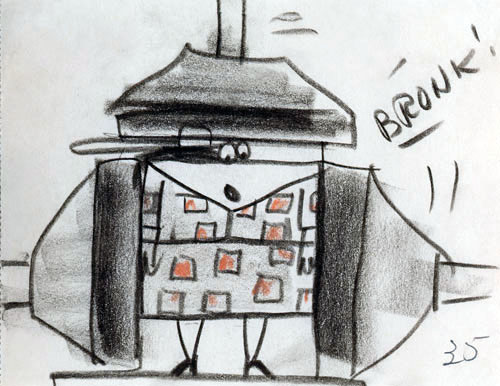
In 1944, the Walt Disney Studio was struggling to survive. World War II, with no end in sight, cut off essential income from Disney’s European film markets.
Substantial debt lingered from lavishly produced, pre-war box office failures, Pinocchio and Fantasia (both released in 1940), the construction of an expensive new studio in Burbank, and a 1941 labor strike. The huge financial problems of Walt Disney and his business partner and brother, Roy, necessitated that they produce, almost exclusively, Armed Forces training films and home front propaganda shorts for the duration of the war.
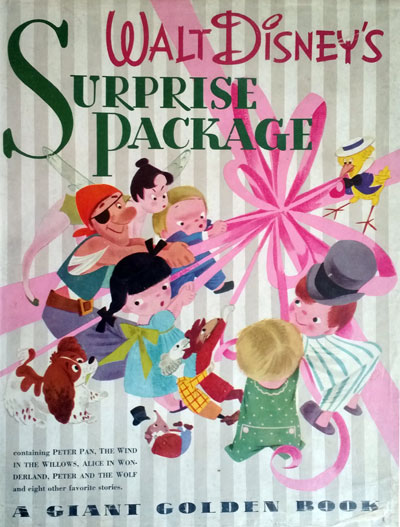 During this difficult period, Walt also optimistically planned numerous post-war film productions. To whet the public’s appetite for his future filmic dreams, he previewed them in, of all places, a children’s book titled Walt Disney’s Surprise Package, published by Simon & Schuster in July 1944.
During this difficult period, Walt also optimistically planned numerous post-war film productions. To whet the public’s appetite for his future filmic dreams, he previewed them in, of all places, a children’s book titled Walt Disney’s Surprise Package, published by Simon & Schuster in July 1944.
Surprise Package is a historical document of sorts — a fascinating glimpse into the Disney Studio’s creative process at a crucial time in its history. Uncle Remus Stories; Happy Valley (later titled Fun and Fancy Free); The Wind in the Willows (later The Adventures of Ichabod and Mr. Toad; Alice in Wonderland; Peter Pan, were priorities among the hoped-for future projects, and all eventually reached movie screens in 1946, 1947, 1949, 1951 and 1953, respectively.
Adapting classic stories, such as above, for a children’s book was the formidable and thankless task of H. Marion Palmer, wife of Ted (Dr. Seuss) Geisel. The text is predictably bland and succinct.
Much more interesting is Surprise Package’s illustrations. They show designs for now-familiar characters, settings and actions in their earliest conceptual stages of development, far removed from their finalized appearance in films.
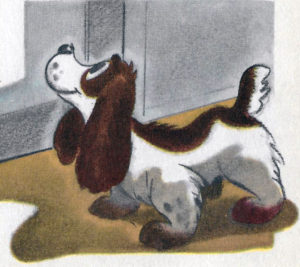
For example, the dog story titled “Lady,” which was finally produced in 1955 as Lady and the Tramp. In Surprise Package, she appears in appealing sketches, perhaps by J. P. Miller (all the artists are unidentified), as a generic pooch — a mottled Springer Spaniel, not the honey-colored, glam version seen on the screen. Though there are two mischievous Siamese cats, she is a Lady without her Tramp, the charming mutt with whom, eleven years later, she shared main-title billing and a spaghetti dinner.
Equally fascinating in Surprise Package are the illustrated stories that the studio never produced, including three by Hans Christian Andersen, for a feature comprising a collection of tales explored in sketches as early as 1937: The Little Fir Tree; The Emperor’s New Clothes; and seventeen pages devoted to Through the Picture Frame, adapted from Ole Lukoie.

The latter story’s free-form pastel drawings, filled with gentle, inventive whimsy, are by Bianca Majolie, who, in 1935, was the first woman story artist Disney hired. In a 1987 correspondence with me, Ms. Majolie said she drew the illustrations, plus a couple more included in a September 1944 book, also titled Through the Picture Frame, one of the first titles in the Walt Disney Little Library series.
The most unusual entry in Surprise Package is The Square World, an original story by Disney Studio’s star writer/artists at the time: the prolific Joe Grant and Richard (Dick) Huemer, who produced Fantasia and developed Dumbo. During the war, the team wrote/produced numerous film stories for the home front, such as the Oscar-winning Der Fuehrer’s Face (1943). See my 2010 book, Two Guys Named Joe, for more about the extraordinary life and careers of Joe Grant.
The Square World was Grant/Huemer’s protest against totalitarianism, racism, and loss of personal freedom. In the text, adapted by Palmer from Huemer’s original pun-filled rhymes, the allegory concerns people in the land of What’s-It’s Name (“Wotzitsname” in Huemer’s version), who, like everyone, have many shapes.

Mighty-Highty-Tighty (“Hi-Mucki-Muck”), the megalomaniacal ruler, is squat and square. He declares, “I do not like so many shapes. My shape is the right shape!” His soldiers set forth to remake the entire world into square shapes, including people, buildings, cars, trees, even chickens and their eggs. When babies continue to be born in a diversity of shapes, Mighty-Highty-Tighty commits suicide.
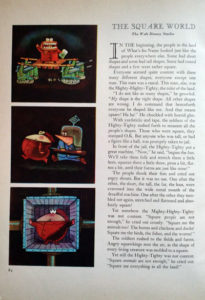

Six color drawings on two pages accompanying the story, drawn for Surprise Package by Joe Grant, are in a modernist stylization unusual for Disney. They resemble European poster graphics, which United Productions of America (UPA) later adopted for their short cartoon films, such as Gerald McBoing Boing (1951).
Children could relate to the small, soft and round creatures of the story put upon by aggressive, sharp-cornered bullies. But the real target of the two writer/artists were adults who’d understand the story is, in Richard Huemer’s words, “bitterly satirizing totalitarianism, á la Hitler or Mussolini, or any other aspiring dictator.”
Why was the film not produced? “It was in the waning days of the war that the storyboards were ready for presentation to Walt for okay to go ahead on production,”Huemer explained in a Foreword to a 16-page rhyme he wrote “based loosely” on the cartoon story.
Walt was not there. Instead (which was most unusual) Roy Disney, who very seldom had any connection with the creative mechanics of the studio, was in charge. After the storyboards had been read and explained to the group, Roy lost no time in stating that we ought not to make this picture. Not that it lacked merit. Far from it. But that now, that the end of hostilities was definitely in sight (at least in Europe) we perhaps ought to soft-pedal any slaps at our erstwhile enemy. We are going to have to do business with whatever government takes over in Germany, so we oughtn’t create any further ill will,” said he. And that was that, and an opinion that was reasonable enough.
The boards were put away . . .
Another reason why The Square World disappeared was offered by Joe Grant. Interviewed by animation historian Michael Barrier on October 14, 1988, when asked who did the Surprise Package drawings, Grant said:
Those are my drawings. I have quite a few of them that I did that weren’t published. I wish we had made that picture. I told you I have the letters from the legal department that they thought it was too communistic.
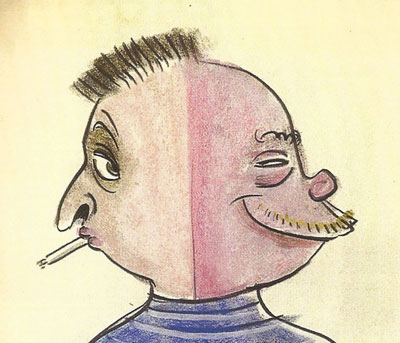
Thanks to Jim Hollifield, Richard Huemer, Jr., Didier Ghez, Michael Barrier.
All Disney Images are ©Disney and are shown here for educational and inspirational purposes only.
Hits: 68838

Fascinating! Who now has the drawings that Joe Grant held onto?
Well! This is a surprise.
I have just read and enjoyed your blog about Disney’s aborted project on the Square World, on which Disney and Grant-Hume expended a great deal of effort. The 3 of them even flew East where Disney visited Earnest Hooton at Harvard. Fie on that legal department! They probably think that Friedrich Hayek, Murray Rothbard, and Ludwig von Mises typify ideal Soviet commissars.
l’ve been putting the finishing touches on my “Square World” presentation for the Hyperion Historical Alliance on April 30. It’s a narration with sound effects, like old-time radio drama, plus slides. I’ve always loved the story since my Dad brought the story sketches home in booklet form when I was about 10 years old. I’ll send you the audio, if you wish, after I’ve presented it. I can’t send the pictures because some belong to “a collector” who doesn’t want them to go public, and one is embargoed by Harvard.
BTW, my Dad and I have different middle names, so I’m no “Junior” although I am a chip off the old block.
Regards,
RPH
Richard P. Huemer, M.D.
Thanks for your thoughtful work.